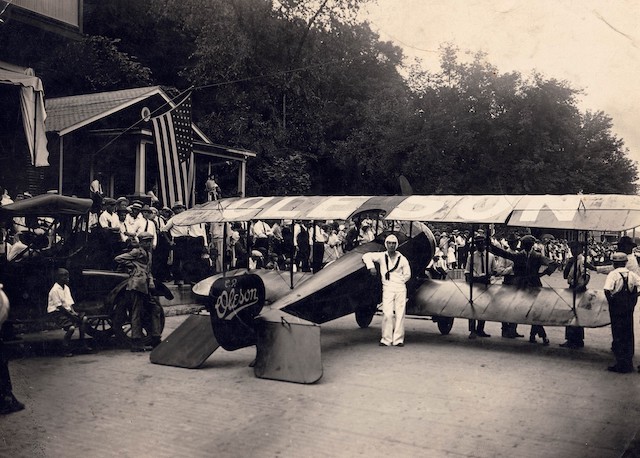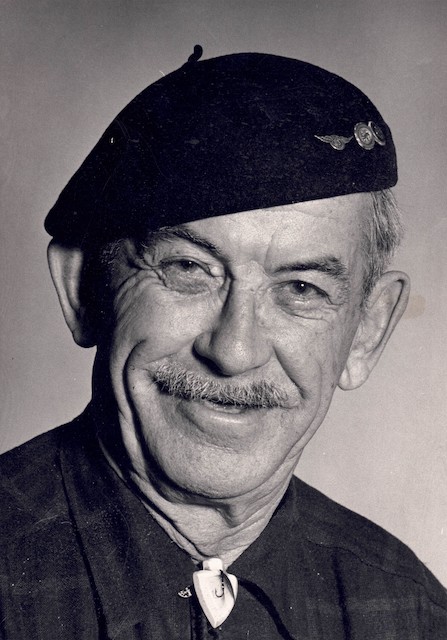
Clifton Oleson before taking off down Main Street in McGregor in 1923. Photo courtesy of Iowa Aviation Museum
May/June 2024 (Volume 16, Issue 3)
By Matthew Walsh
Thousands of spectators flocked to Dubuque in September 1911 to watch stunt pilot Lincoln Beachey perform, including a mock battle between Beachey and “the Dubuque militia.” At low altitude, the famed aviator raced past a motorcycle. Then he executed “The Dip of Death” by plummeting to the ground with his hands off the controls. He pulled up at the last moment with his knees, smiling and waving to the admiring multitude below. But hearts raced the most when Beachey demonstrated his trademark death spiral. While other pilots caught in such a tailspin perished trying to turn against the spin or to pull up, Beachey discovered turning into the spiral and nosing downward created control.
When Beachey landed after the death-defying show, a 12-year-old Boy Scout from Iowa named Clifton Oleson could contain himself no longer. He sprinted through the crowd, ducked policemen, hopped through ropes and proclaimed to Beachey, “I, too, am going to fly someday.” An angry officer tried to pull away the youngster, but Beachey called him off: “Let him alone. That’s the kind of nerve that makes aviators.”
During the early 20th century pilots needed to have nerves of steel as about one-third of flights at the time ended with a crash. In 1911, for instance, Iowan Euguene Ely defeated Beachey in a 12-mile race held in Chicago, Ill. Two months later, Ely crashed and broke his neck in Macon, Ga. Spectators swarmed to the wreckage and stripped the dying man’s body for souvenirs. Ely’s body was returned to Davenport for burial on his 25th birthday.
Beachey completed many more accomplishments, including besting race car driver Eddie Rickenbacker at the 1914 Iowa State Fair. A year later, he maneuvered his inverted 80 horsepower monoplane too hard, causing the wings to shear off. He hit San Francisco Bay at nearly 200 mph. While submerged, Beachey struggled to remove his restraints and drowned. Oleson, the youngster from Iowa that Beachey inspired, would become one of the world’s most famous and tenured pilots. His 50-year flying career would take him around the world, but it always brought him back to the Hawkeye State.

Clifton Oleson sporting his trademark beret in 1967. Photo courtesy of Iowa Aviation Museum
Clifton P. Oleson was born on Aug. 7, 1899, in McGregor, the son of Ben and Nellie Oleson. One year after seeing Beachey, the 13-year-old budding aviator enjoyed his first ascent in The Flying Benoist, an amphibious plane built in Davenport. Oleson, nicknamed “Tuffy,” studied piloting at the prestigious Curtiss Exhibition School in Miami, Fl. Oleson specialized in the hydroaeroplane, making him a “birdman.” In April 1917, the 18-year-old earned license No. 67 from the Aero Club of America, distinguishing himself as the youngest pilot in the nation. Uncle Sam needed the birdman’s talents as the United States military was short of aviators at the start of World War I.
Oleson volunteered for service with the U.S. Army Aviation Section of the Signal Corps on registration day, joining 49 others from his hometown. More than three percent of McGregor’s 1,244 residents volunteered by June of 1917; many possessed a fighting spirit in the city founded by a descendent of legendary Highlander Rob Roy MacGregor. Oleson’s older brother, Rollin, joined the 42nd Infantry Division of the U.S. Army National Guard, best known as the Rainbow Division, and served in France. But it was Tuffy who owned the spotlight as the U.S. War Department proclaimed him “the youngest aviator in the Army.”
Oleson served in the U.S. Army Signal Corps and obtained the rank of master signal electrician, a specialist responsible for the condition of technical equipment. He remained stateside to train older pilots for the duration of the war. Tuffy recalled, “The Army felt if you knew how to fly, they kept you on as an instructor.” Oleson taught pilots on the Glenn Curtiss JN-4D, nicknamed “Jenny.” The aircraft ushered in the age of the barnstormer and Oleson wanted in on the action.
TO READ THE ENTIRE STORY AND OTHER FASCINATING STORIES ABOUT IOWA HISTORY, subscribe to Iowa History Journal.
